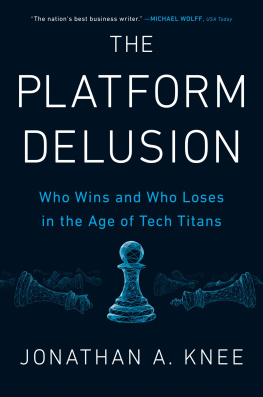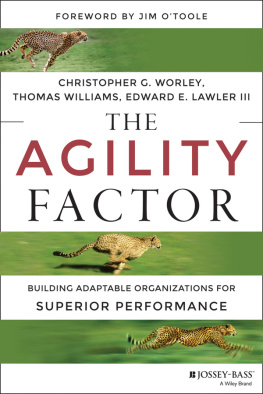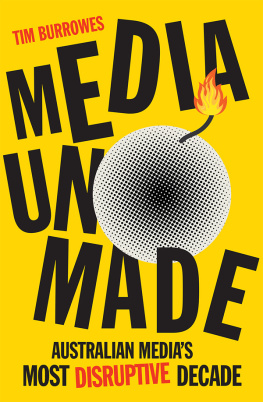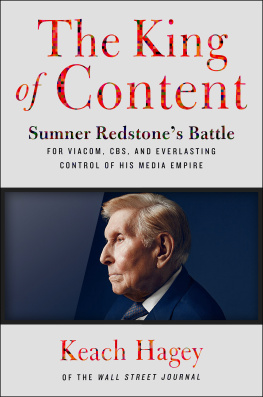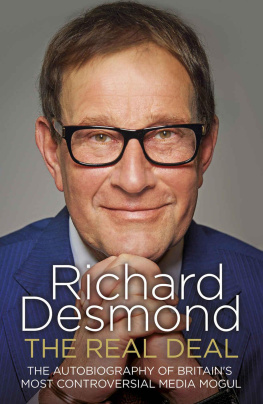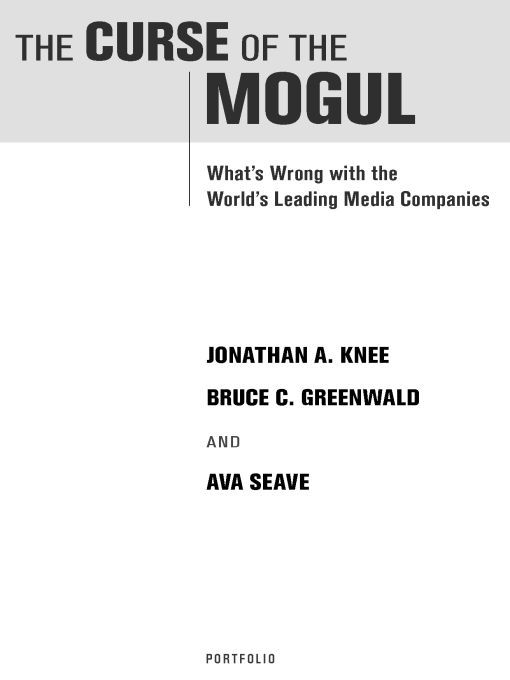Table of Contents
To the great teachers in our past
Jonathan A. Knee: Sigmund Koch, Alasdair MacIntyre, Judith Sadowsky
Bruce C. Greenwald: Dave Bradford, Bill Branson, Bob Solow
Ava Seave: Michael Harper, Jim McLaughlin, Leonard Murphy
Acknowledgments
This book grew out of the Strategic Management of Media course we offer at Columbia Business School, and so our greatest debt is to the hundreds of students and dozens of visiting media executives who have contributed to the discussions that have filled that classroom and shaped our thinking. In this regard, Phyllis Grann and Erin Bellissimo played a unique role in formulating and teaching the course since we began in 2003.
Over the course of this project we have had a number of diligent and resourceful research assistantsElizabeth Milonopoulos, Justin Katz, Charles Murphy, Andrew Welch, Jane Edellwho helped gather the data on which the book is based. Karen Entwistle and Linda Neithardt helped keep us organized, if such a thing is possible. A long list of friends and colleagues have given feedback on the manuscript, provided some key pieces of data, or offered much-needed moral support. These include Judi Allen, Alison Anthoine, Christine Arrington, Alan Axelrod, Soren Bech, Beatrice Cassou, Anne Chen, Margaret Downs, Mark Gerson, Carla Graubard, Diana Greenwald, Nick Greenwald, Erica Gruen, Jean Hellering, Ruth Jarmul, Judd Kahn, Anne Kinard, David Knee, Elizabeth Koe, Myra Kogan, Melody Koh, Andrew Lipsher, Lisa McGahan, Chaille Maddox, John Edward Murphy, Lawrence M. Nagin, David Ow, Scott Patrick, Eric Rosen, Jason M. Sobol, Patrick Tierney, Gayle Turk, Hal Vogel, Paul Wojcik, and Almahdi Yousif. We are also lucky to have understanding and thoughtful agents in Elaine Markson and John Wright, who were wise enough to direct us to Adrian Zackheim at Portfolio as the right editor for this project. Our experience has confirmed their excellent judgment. Many others at Portfolio have provided great support, but Courtney Young in particular has helped make the book far more accessible to a general audience than any of us thought possible.
The authors, in addition to teaching and writing, have served as consultants and advisers to a variety of media companies, including some of those covered in this book. Although these experiences cannot have helped but inform our general perspective, this book is based exclusively on public information and selected interviews undertaken for that explicit purpose. The views expressed here should not be attributed to any organization or individual other than the ornery authors themselves. Although everyone knows that no good deed does go unpunished, it would be cruel and unusual to ascribe our idiosyncratic perspective to anyone kind enough to help us out on this project or generous enough to employ us. The buck stops with us.
Introduction:
The Curse of the Mogul
Hooray for Hollywood! Or maybe not.
The media industry is facing multiple financial and operational crises on an unprecedented scale. Just since 2000, the largest media conglomerates have written down $200 billion in assets from their collective balance sheets. These write-downs represent the real destruction of value from relentlessly overpaying for acquisitions, strategic investments, and contracts for content and talent. The magnitude of these losses also reflects the level of desperation among media moguls faced with new competitors, new technologies, and new customer demands.
As new as many of these challenges are, one aspect of the media business has remained unchanged for a generation: The performance of the leading companies has been lousy. Although things are getting worse, this has as much to do with the inability of the moguls to effectively adapt as with the underlying conditions. The basic approaches to confronting these challenges articulated by the leading executives will only exacerbate the problems. This book explains why these companies are following such self-destructive paths and proposes a radically different way to think about media businesses and their strategies. Understanding media and the historically fraught relationship with their moguls is essential to successfully navigating the changing landscape. The urgent issues we raise should matter to anyone who cares about the fate of the media sectorwhether as a manager, as an investor, or as a consumer.
Our task is complicated by the aura of mystery that perennially cloaks the business of media. Today, even the biggest celebrity cannot escape the watchful eye of YouTube, TMZ.com, or smokinggun.com, but the same level of transparency doesnt apply to the operations of the media industry itself. This general lack of understanding about the media business derives in part from the nature of the unusually intense interest in the sector.
The media industry is a vast, heterogeneous web of enterprises representing hundreds of billions of dollars of value. Yet those segments that attract public and press attention do so based largely on their celebrity value, without regard to their relative size or profitability. The public is far more likely to pay attention to the replacement of an executive at a small, unprofitable hip-hop label than to the combination of two multibillion-dollar, high-margin yellow page companies. This disconnect between interest and actual economic value is not due just to our involvement in the media we use and experience on a regular basis. If that were the case, yellow pages would attract far more attention, as would consumer products companies in general. But how many people know the name of the CEO of Procter & Gamble as compared with Rupert Murdoch, despite the fact that P&G has many times the market value of News Corporation? Tide detergent, however, is better known than either Murdoch or the head of P&Gwho happens to be Robert McDonald, a twenty-nine-year company veteran who became CEO in July 2009. What other consumer products sales figures draw such broad public notice as weekend films opening box-office receipts?
A second, subtler but equally powerful explanation for the level of both interest and confusion is a peculiarly American paranoia about the media industrys ability and inclination to mold the national psyche. This suspicion is reflected most prominently in articulated fears about the diversity and independence of news but extends to broader fears about potential cultural indoctrination by massive malevolent media conglomerates. These fears seem largely impervious to the dramatic and accelerating trends toward increased media fragmentation. In 2008, the top-twenty circulation newspapers in the United States had fifteen different owners, and only one of the half-dozen major media conglomerates owned any of them. Furthermore, these conglomeratesand indeed all traditional media outletshave been rapidly losing share of both mind and revenue to relatively new and fiercely independent market entrants like Google.
The extent of these fears is reflected in a bizarre and incoherent labyrinth of regulations governing the ownership of media in the United States. Cable operators in a market can own local newspapers, TV or radio stations, but the broadcasters and newspaper publishers generally cant own each other; a foreigner can own a newspaper, cable franchise, or movie studio but not a radio station; satellite TV operators or cable channel owners have no preset limit on how much of the country they can reach but broadcasters can only own stations reaching 38 percent of the country; and on and on.


